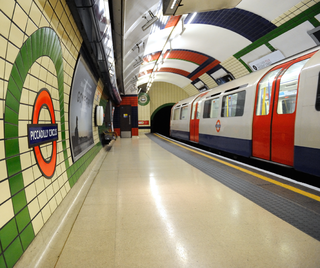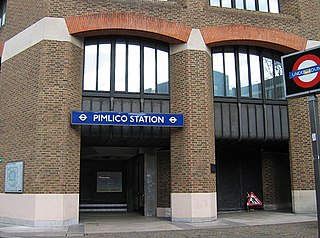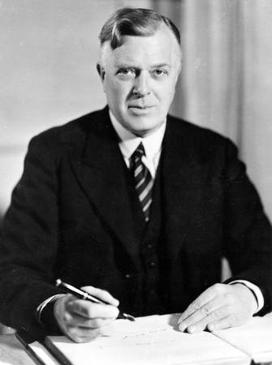
The London Underground is a rapid transit system serving Greater London and some parts of the adjacent home counties of Buckinghamshire, Essex and Hertfordshire in England.

The Tube map is a schematic transport map of the lines, stations and services of the London Underground, known colloquially as "the Tube", hence the map's name. The first schematic Tube map was designed by Harry Beck in 1931. Since then, it has been expanded to include more of London's public transport systems, including the Docklands Light Railway, London Overground, the Elizabeth line, Tramlink, the London Cable Car and Thameslink.

Piccadilly Circus is a London Underground station located directly beneath Piccadilly Circus itself, with entrances at every corner. Located in Travel-card Zone 1, the station is on the Piccadilly line between Green Park and Leicester Square and on the Bakerloo line between Charing Cross and Oxford Circus.

East Finchley is a London Underground station in East Finchley in the London Borough of Barnet, north London. The station is on the High Barnet branch of the Northern line, between Finchley Central and Highgate stations, and is in Travelcard Zone 3.

Kilburn is a London Underground station near Brondesbury Park in north-west London. It is on the Jubilee line, between Willesden Green and West Hampstead stations and is in Travelcard Zone 2. The station is on the A5 Kilburn High Road or Shoot-up Hill, approximately 0.1 miles (0.16 km) north of Brondesbury station. Metropolitan line trains typically bypass the station without stopping.

Goodge Street is a London Underground station on Tottenham Court Road in Fitzrovia, in the London Borough of Camden. It is on the Northern line's Charing Cross branch between Warren Street and Tottenham Court Road stations, and is in Travelcard Zone 1.

Pimlico is a London Underground station in Pimlico, City of Westminster, on the Victoria line between Victoria and Vauxhall in Zone 1. It was a late addition to the Victoria line, not appearing in the original plans, and the last to open in 1972.

Mill Hill East is a London Underground station in Mill Hill in the London Borough of Barnet, north London. The station is the terminus and only station of a single-track branch of the Northern line from Finchley Central station and is in Travelcard Zone 4. It is the least used station on the Northern line with 0.76 million passengers in 2021.

Johnston is a sans-serif typeface designed by and named after Edward Johnston. The typeface was commissioned in 1913 by Frank Pick, commercial manager of the Underground Electric Railways Company of London, as part of his plan to strengthen the company's corporate identity. Johnston was originally created for printing, but it rapidly became used for the enamel station signs of the Underground system as well.

Muswell Hill railway station was in Muswell Hill in North London, just north of the junction of Muswell Hill and Muswell Hill Place. Nothing remains of the station and Muswell Hill Primary School now occupies its former site. In the 1930s, plans were made to electrify the line and transfer the mainline service to London Underground's Northern line, but these were abandoned after the Second World War. The station closed for passengers in 1954 and goods in 1956.

Cranley Gardens railway station was a station in the Muswell Hill area of north London. It was located between Highgate and Muswell Hill stations, at the junction of Muswell Hill Road and Cranley Gardens. Nothing remains of the station today and its site is now occupied by housing and a school. In the 1930s, plans were made to electrify the line and transfer the mainline service to London Underground's Northern line, but these were abandoned after the Second World War. The station closed for passengers in 1954 and for goods in 1957.

Frank Pick Hon. RIBA was a British transport administrator. After qualifying as a solicitor in 1902, he worked at the North Eastern Railway, before moving to the Underground Electric Railways Company of London (UERL) in 1906. He was chief executive officer and vice-chairman of the London Passenger Transport Board from its creation in 1933 until 1940.
Stanley A. Heaps (1880–1962) was an English architect responsible for the design of a number of stations on the London Underground system as well as the design of train depots and bus and trolleybus garages for London Transport.

Mark Ovenden F.R.G.S. is a broadcaster and author who specialises in the subjects of graphic design, cartography and architecture in public transport, with an emphasis on underground rapid transit.

Art on the Underground, previously called Platform for Art, is Transport for London's (TfL) contemporary public art programme. It commissions permanent and temporary artworks for London Underground, as well as commissioning artists to create covers for the Tube map, one of the largest public art commissions in the UK.
Cyril Edward Power was an English artist best known for his linocut prints, long-standing artistic partnership with artist Sybil Andrews and for co-founding the Grosvenor School of Modern Art in London in 1925. He was also a successful architect and teacher.

Enid Crystal Dorothy Marx, RDI, was an English painter and designer, best known for her industrial textile designs for the London Transport Board and the Utility furniture Scheme. Marx was the first female engraver to be designated as a Royal Designer for Industry.

London Transport (LT) was the public name and brand used by a series of public transport authorities in London, England, from 1933. Its most recognizable feature was the bar-and-circle 'roundel' logo. With its origins in the Underground Electric Railways Company of London (UERL), the brand was first used by the London Passenger Transport Board (LPTB) to unify the identity of the previously separately owned and managed London Underground, Metropolitan Railway, bus and tram services. The London Transport brand was extended under the direction of Frank Pick to all aspects of transport operation including poster designs, tickets, train livery, seat upholstery and the station architecture of Charles Holden. When public transport operation was taken over by Transport for London (TFL) from London Regional Transport (LRT) in 2000, the London Transport brand was discontinued and replaced with Transport for London's own branding, which incorporates many features of the London Transport brand including the 'roundel' symbol and the Johnston font.
Emma Kay is a British artist working with subjectivity and memory.
Lilian Margery Dring was a British artist known for her paintings, poster designs and textile designs. needlework and embroidery work.
















